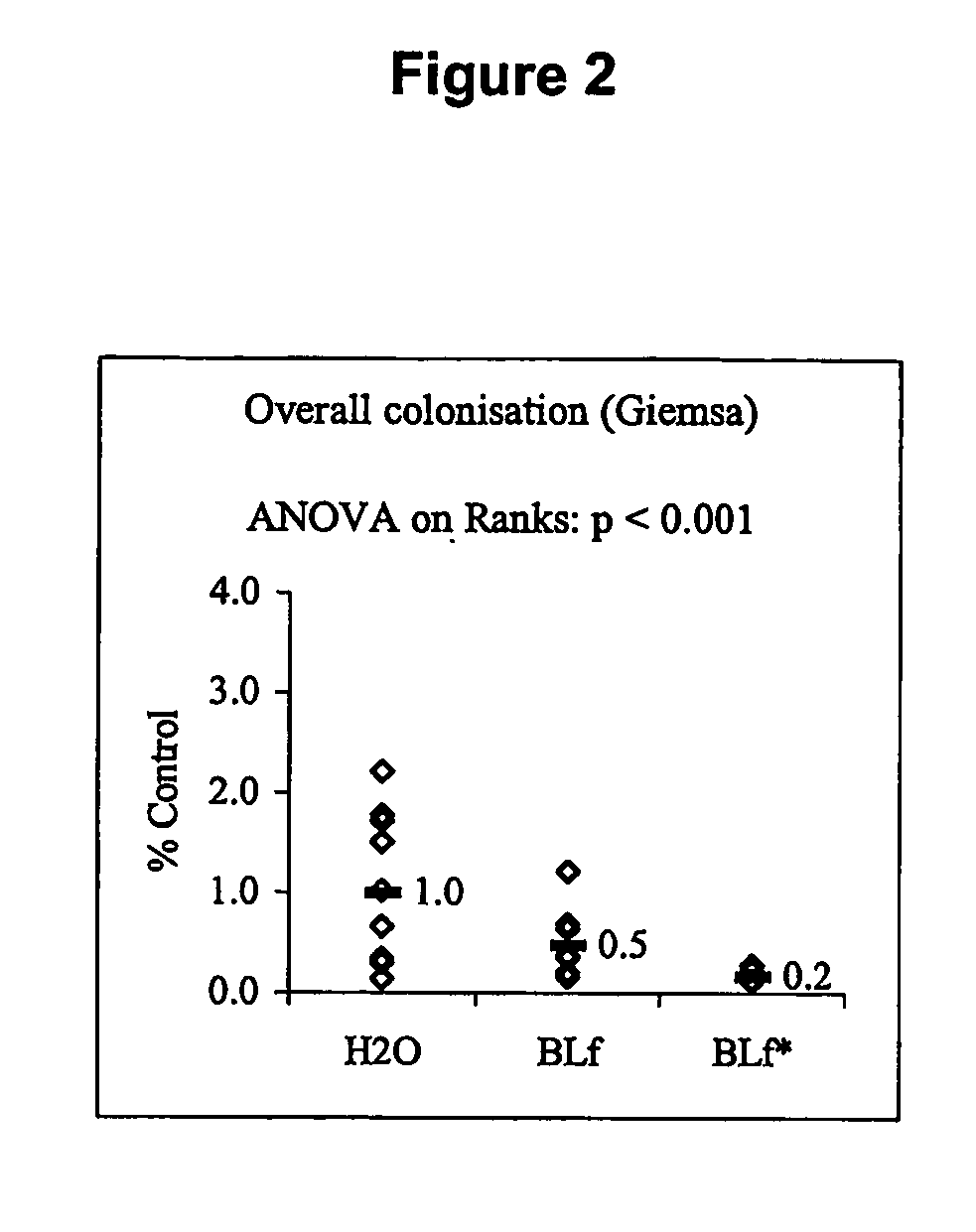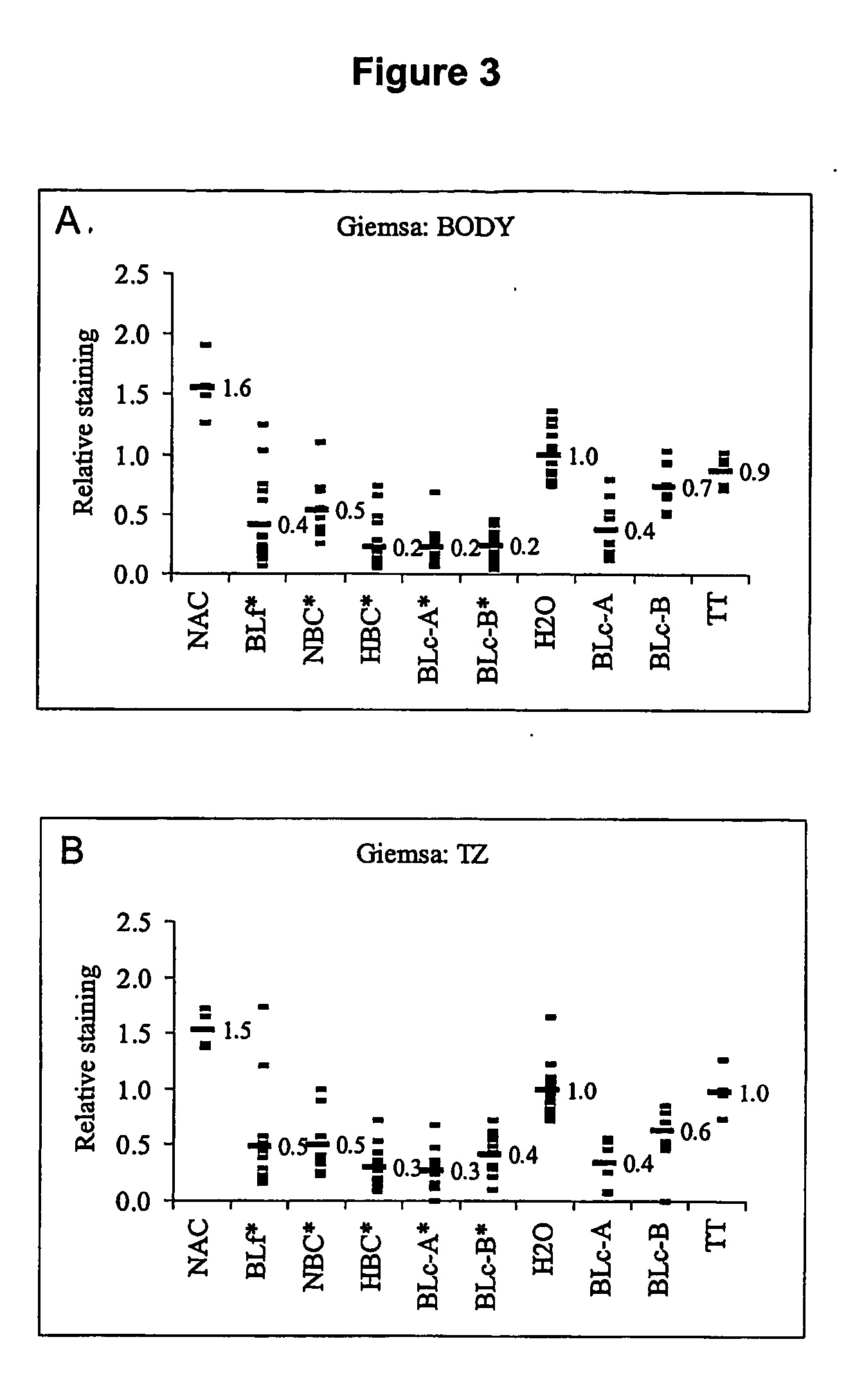Method for inhibiting bacterial colonisation
a technology of bacterial colonisation and inhibition, which is applied in the direction of antibody medical ingredients, peptide/protein ingredients, transferrins, etc., can solve the problems of acid and pepsin damaging the stomach, further damage to the stomach, and inflammation of the gastric mucosa, so as to reduce the bacterial infection of the mucous epithelium, reduce inflammation, and reduce the effect of bacterial infection
- Summary
- Abstract
- Description
- Claims
- Application Information
AI Technical Summary
Benefits of technology
Problems solved by technology
Method used
Image
Examples
example 1
Model for Bacterial Colonisation
[0307] Female C57BL / 6 mice, approximately six week old, were orally inoculated with Sydney strain 1 (SS1) of H. pylori (1.0×108 bacteria delivered in 0.1 ml of 0.9% (w / v) sodium chloride) according to Lee et al., (1997) Gastroenterology 112:1386-1397 (the entire disclosure of which is incorporated herein by reference) and treated twice daily by oro-gastric gavage for 21 days, starting 4 weeks after inoculation (Scheme 1 below). Animals were housed in the Animal House at the Women's and Children's Hospital. All animals were fed mouse chow and water ad libitum.
example 2
Treatment
(a) Test Sample Preparation:
[0308] N-acetyl cysteine (NAC; Sigma Chemical Co., St Louis, Mo.) was dissolved in distilled water at 5% (w / v) and stored at 4° C. until use.
[0309] Non-immune bovine colostrum was prepared by pooled milkings. The freeze-dried powder was dissolved in distilled water at 20% (w / v) and stored at −20° C. prior to use.
[0310] Hyperimmune bovine colostrum (HBC; pooled milkings, freeze-dried powder) was dissolved in distilled water at 20% (w / v) and stored at −20° C. prior to use. Bovine lactoferrin (DMV International, Netherlands) was dissolved in distilled water at 3% (w / v) and stored at −20° C. until use.
[0311] Bovine lactoferrin hydrolysate-A (BLc-A) was prepared by proteolytic digestion of bovine lactoferrin with porcine gastric pepsin. The pH of the bovine lactoferrin solution was adjusted to pH 2.5 and porcine pepsin (Sigma) added at a final concentration of 3% (w / w of substrate). Hydrolysis was performed at 37° C. for 30 min and terminated b...
example 3
Assessment of Bacterial Colonisation and Pathology
[0316] Mice were killed by CO2 asphyxiation followed by cervical dislocation and gastric tissue was collected for histological examination, bacterial culture and biochemical analysis as described previously in Lee et al. (1997) Gastroenterology 112:1386-1397 and also in Krawisz et al. (1984) Gastroenterology 87:1344-1350.
[0317] Briefly, the stomach was removed then cut along the greater curvature and rinsed in sterile saline to eliminate the stomach contents. Half of the tissue was fixed in 10% neutral buffered formalin, embedded in paraffin, cut into 5 μm sections and stained with hematoxylin and eosin (H & E) for histology and May-Grünwald-Giemsa (Giemsa) stain to assess bacterial colonisation. The remaining tissue was placed in 2 mL of sterile saline, weighed and homogenised for 30 seconds with an Ultra-Turrax homogeniser (Janke & Kenkel, Germany).
[0318] For bacterial culture, serial tenfold dilutions of tissue homogenate were...
PUM
| Property | Measurement | Unit |
|---|---|---|
| Biological properties | aaaaa | aaaaa |
| Antimicrobial properties | aaaaa | aaaaa |
Abstract
Description
Claims
Application Information
 Login to View More
Login to View More - R&D
- Intellectual Property
- Life Sciences
- Materials
- Tech Scout
- Unparalleled Data Quality
- Higher Quality Content
- 60% Fewer Hallucinations
Browse by: Latest US Patents, China's latest patents, Technical Efficacy Thesaurus, Application Domain, Technology Topic, Popular Technical Reports.
© 2025 PatSnap. All rights reserved.Legal|Privacy policy|Modern Slavery Act Transparency Statement|Sitemap|About US| Contact US: help@patsnap.com



